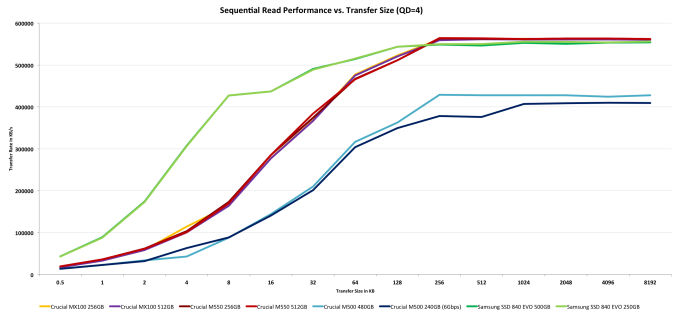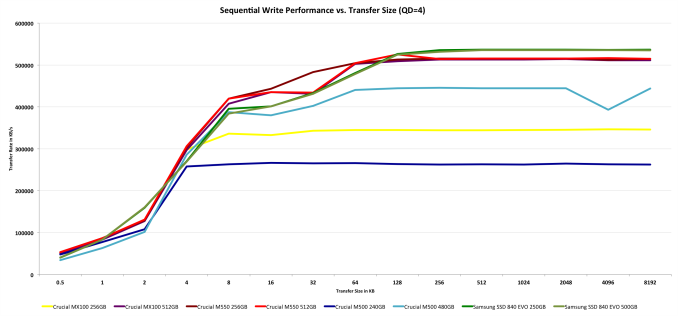Crucial MX100 (256GB & 512GB) Review
by Kristian Vättö on June 2, 2014 3:00 PM ESTPerformance vs. Transfer Size
ATTO is a useful tool for quickly benchmarking performance across various transfer sizes. You can get the complete data set in Bench. Performance scaling appears to be identical to M550, which is a healthy upgrade from the M500 but still falls behind the 840 EVO in read performance.
Click for full size












50 Comments
View All Comments
blanarahul - Monday, June 2, 2014 - link
Crucial sucks balls at making performance drives.. They should leave that market to Sandforce and Samsung, and concentrate on beating Samsung in value SSD market...hojnikb - Monday, June 2, 2014 - link
Sandforce makes performance drives ?!hahahah thats new :)
MrSpadge - Wednesday, June 4, 2014 - link
Please read the article.SmilingTornado - Thursday, June 5, 2014 - link
I am pretty sure this would be a "budget" SSD because of the $110 price tag and the fact that TigerDirect would be selling it for as little as $100 if you get a coupondanwat1234 - Monday, January 26, 2015 - link
No need for more performance than sandforce 2xxx, that pretty much eliminates the hard drive bottleneck completely for most uses in home computersEricZBA - Monday, June 2, 2014 - link
Already instock at Amazon. Sweet! http://www.amazon.com/Crucial-MX100-adapter-Intern...Hrel - Monday, June 2, 2014 - link
"Sequential Write 150MB/s 330MB/s"Why so slow? Especially when $100 drives get 550MB/s at 95k IOPS.
hojnikb - Monday, June 2, 2014 - link
Where do you have 100$ drive, that gets 550MB/ write ?!extide - Monday, June 2, 2014 - link
This is explained in the article... But it is because it uses fewer large capacity NAND dies to hit the low prices. For fast writed with NAND you need lots of dies, which is why the bigger versions of this drive see better performance.hojnikb - Monday, June 2, 2014 - link
And competitors are using nasty tricks like turbowrite or compression to achive such write speeds. But actual nand inside those mainstream drives isn't capable of such speeds.